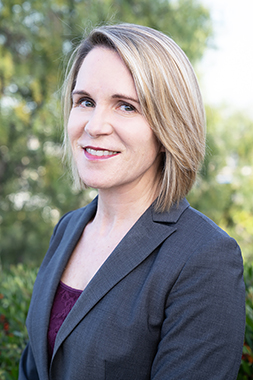Chat with Sarah Steenhausen, Deputy Director of Aging Policy, Research and Equity, California Department of Aging
 Can you talk about why caregivers, paid and unpaid, deserve more recognition for what they do?
Can you talk about why caregivers, paid and unpaid, deserve more recognition for what they do?
That’s an important question – probably the most important question that we are facing today as a state. Caregivers are critical to advancing all we’re trying to do to create an aging and disability-friendly California. At some point in our lives, most Californians will seek care from family, friends, or paid caregivers. And at the same time, many of us will have the privilege of caring for an older adult or loved one as well. So, supporting caregivers for adults is essential for all aspects of our family life, and the economy, and for California.
It’s also because we see that workforce is an equity issue. We know that women, particularly Black, Indigenous, Latina, and Asian American women, are providing a disproportionately large share of this care, often while they are caring for their own children. Yet, these direct care workers earn less than half of our median annual income. One in four falls below the federal poverty line. We know low wages adds to stress, contributes to injury potential and reduced prospects for financial stability, and income for the unpaid family caregivers. As much as the work is very rewarding, the time it takes to care for a loved one can result in a lot of financial hardship and a decrease in social security earnings. We want to make sure we’re supporting caregivers to address those equity issues and to meet the needs of our population.
Finally, it’s a very timely and urgent issue. Our stats say that we’re going to face a labor force shortage of up to 3-3.2 million paid direct care workers. So, this just underscores why we need to build a culturally competent workforce to meet the needs of our diverse population.
Why is the pay typically so low – where does that disconnect come from?
In terms of how we view aging as a society, I think on a broad level it reflects the value that we put on aging, and our societal bias that fears aging and disability. What we need to do is change the paradigm and see that aging is about all of us. We all stand to benefit from making California a place where people can age with dignity and independence. And we should value the contributions of people who have given their lives to our society. If we can change the paradigm to not be equated with loss and isolation, and instead recognize that the value and contributions of our aging population are what really make the fabric of our society so rich.
We think what we’ve outlined in the Master Plan for Aging is a critical component to this. The specific initiatives that we’ve outlined in Strategy B as part of the broader “Caregiving That Works” (Goal 4) are critical to developing the training, career ladders, the incentives, and the pipeline to expand our workforce.
What is Strategy B of Goal 4 of the Master Plan all about?
Goal 4 provides a framework to address the needs of paid and unpaid caregivers. We think that good caregiving jobs creation means focusing on growing the workforce through training, professional development, livable wages, job placement support and improved job quality. The strategy focuses on convening a solutions table with partners across our agency to address workforce supply challenges and opportunities in skilled nursing facilities, and expand online training platforms, including the development of career ladder and career lattices for those who want to continue building their training and experience. Finally, we need to diversify the pipeline for direct care workers in home and community-based settings by testing some of the promising and emerging models that have started to evolve.
What the difference between a career “ladder” vs. “lattice”?
A lattice enables you to work more efficiently and seamlessly across the different job categories, so it’s a progression pathway that allows for vertical, horizontal, and diagonal movement. So, it doesn’t just mean you’re moving up the ladder. If I’m a home health aide, I might also be able to work as a CNA, because many of the skills are the same. But the way we’ve structured it now, you must go through separate licensure, training, redo as many hours as necessary for that job category, and it prevents a lot of our workers from taking advantage of different positions across the continuum.
Can you highlight some of your current initiatives that address what’s outlined in Strategy B?
We’re excited about the investment made in the 2021-2022 budget – nearly one billion in building training opportunities and incentives for Direct Care workers in the home and community setting and nursing facilities. Second, we’re excited about the Governor’s proposed budget, which includes initiatives with historic investments of 1.7 billion of over three years in both the care economy workforce, and essentially recruiting, training, and hiring, and advancing an ethnically and culturally inclusive workforce. There are many components to this, one of which is building out our community health workers initiative, to recruit, train, and certify 25,000 new community health workers.
Something that I think would be of significant interest to LeadingAge is the 21st Century Nursing Initiative, which includes $270 million to increase the number of RNs, LVNs, CNAs, midwives, Certified Medical Assistants, Nurse Practitioners, and other health professions. So again, the intersection with aging and the service delivery system is significant. And I know that LeadingAge has been engaging in a lot of conversations to consider how those funds might be utilized.
As you work towards the target of one million quality caregiving jobs outlined in Goal 4, what’s a major milestone you’ve hit by this point in the year that you’re proud of?
Building the infrastructure to advance those workers. Data is an important part of this, and we’ll be working closely with our partners to track progress and see where we might be falling short and where we’re succeeding so we can see what’s working. So, we can be sure over the next ten years to hopefully go beyond one million. That’s the goal!
Visit California’s Master Plan for Aging website: mpa.aging.ca.gov



